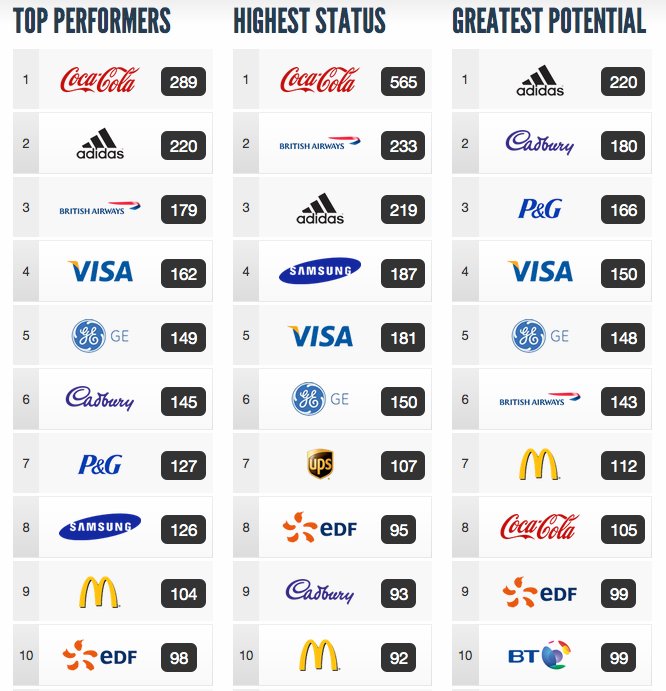Brands
Which Brands Won the Social Media Olympics?
And so, good night, London 2012.
 The months of Olympic swimming, running, jumping, shooting, synchronizing, whacking things with rackets, and standing on podiums with medals — all of this has come to an end.
The months of Olympic swimming, running, jumping, shooting, synchronizing, whacking things with rackets, and standing on podiums with medals — all of this has come to an end.
But while many of the athletes have gone home, at least one score is still being scrutinized — the Sociagility London 2012 Social Scoreboard.
Brands and the London Olympics: Early Stage
Sociagility’s project was to track the engagement of the 25 core sponsors of the London 2012 games, a way for the social-community consultancy to showcase its measurement system, called PRINT.
“Our daily social media effectiveness tracking began on April 18,” said Niall Cook, a principal advisor at Sociagility. “One hundred days out from the start of the Games and it continued through the Games themselves, and carries on, as many of the companies are also sponsoring the Paralympic Games,” starting August 29.
Sociagility ranked the companies by an initial measure of status that was based on “brand power” and “potential” — in this case, the brand’s established engagement activity at the start of the Games. The company tracked the the brands’ websites, Facebook pages, Twitter feeds, and YouTube uploads.
In April 2012, as the scoreboard went up, these were the top three contenders for successful Olympics brand-work:
- Procter & Gamble
- BMW
- Cadbury.
But then, those first 100 days led to changes.
Tallying the Sponsors: Olympic Brands that Came Out on Top
As the London 2012 games got underway, the scores had already shifted so that the original top three had been joined, neck-and-neck, by Coca-Cola, British Airways, and adidas.
“We haven’t spoken to all of the companies, so it’s hard to comment on what they may or may not have done, or indeed whether there was any intention,” said Cook. “That said, in general what we saw was a more prominent use of the brands’ social media channels as other sponsorship activation kicked in.
“In addition, those brands that were engaging in some kind of ongoing dialogue definitely fared better than those who used social media as just another broadcast marketing channel,” he said.
Here are the Sociagility outcomes at the end of the Summer Games:

Only Cadbury held onto a hint of its initial top-three position, landing second in the Potential slot. Procter & Gamble stuck around to win a top-five ranking in the category of Potential, but BMW fell far enough out of the upper tiers that it didn’t even make the top ten in any of the categories.
That’s not enough however, according to Cook, to suggest that the German automaker somehow failed, outright, in relation to the other brands in play.
“I don’t think we can conclude that any of the brands made ‘mistakes’,” he said. “It’s just that some fared better than others. Indeed, the decrease in BMW’s scores over time may simply have been the result of other brands’ scores increasing. Our methodology tracks relative performance, not absolute.”
Strategic Takeaways: Branding via Social Engagement
“Those who established a dedicated Olympics presence early on benefitted from months of active engagement targeted at Olympics fans,” noted Anthony Burgess-Webb, another principal advisor at Sociagility, in an August 13 roundup on the company’s blog.
Brands that held off a bit longer during the run-up to the games also “benefitted from concentration of maximum effort just as wider consumer ‘Games Fever’ peaked,” he wrote.
What happened also breaks out into some key takeaways:
- Bigger brands began to flex muscle and dominate the category of Status. With more money and a legacy of brand identity, a big-gun sponsor might not be the leader of social-media engagement on a daily basis, but they weren’t slipping — when it came to status — because of those incremental changes.
- Strategy won the engagement numbers. According to Burgess, it took a deliberate and well-evidence plan for bringing Web users to the brand to get a company’s ranking up there in that Potential score. Whatever Cadbury started out doing right, it did so all the way through. British Airways, Coca-Cola and Adidas brought their game later in the cycle, but when they did they showed that a brand campaign needn’t be protracted to have a positive effect.
“It would be hard to pinpoint one single takeaway from such an in-depth study, which is still continuing,” said Cook. “But right now I guess we’d say that brands using social media as part of any sponsorship really need to focus on engagement and interaction not just awareness and reach. The brands that have performed consistently well in our study are those that have found ways to engage with their audiences that focus on ‘social’ rather than the ‘media’ aspects.”
Get better at your job right now.
Read our monthly newsletter to master content marketing. It’s made for marketers, creators, and everyone in between.




